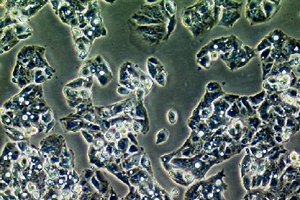Cell line profile Hep-G2
 (ECACC catalogue no. 85011430)
(ECACC catalogue no. 85011430)
Cell line history
Hep-G2 is a human liver cancer cell line that was derived from the liver tissue of a 15 year old Caucasian male with a hepatocellular carcinoma. In 2013 liver cancer was diagnosed in more than 350,000 people and there were over 160,000 deaths after diagnosis; hepatocellular carcinoma is the fifth most common cancer worldwide. The cells secrete a variety of major plasma proteins, for example transferrin and plasminogen. These cells have been successfully grown in large scale cultivation systems.
Key characteristics
This is a perpetual cell line and is non-tumourigenic in nude mice. The major plasma proteins secreted by the cells are albumin, transferrin, fibrinogen, alpha-2 macroglobulin, alpha-1 antitrypsin and plasminogen. Hep-G2 responds to stimulation with human growth hormone; no hepatitis B virus surface antigens have been detected. The cells are adherent epithelial cells growing as monolayers in small aggregates, each containing 55 chromosome pairs.
Applications
Hep-G2 can be used as an in vitro model system for the study of polarised human hepatocytes. With the proper culture conditions, Hep-G2 cells will display robust morphological and functional differentiation with controllable formation of apical and basolateral cell surface domains that resemble the bile canaliculi and sinusoidal domains in vivo. Because of their high degree of morphological and functional differentiation in vitro, Hep-G2 cells are a suitable in vitro model to study the intracellular trafficking and dynamics of bile canaliculi and sinusoidal membrane proteins and lipids in human hepatocytes. This is important for the study of human liver diseases that are caused by an incorrect subcellular distribution of cell surface proteins.
Culture tips
Please see the catalogue entry for culture tips.
Key references
-
Ihrke, G; Neufeld, EB; Meads, T; et al. (1993). "WIF-B cells: an in vitro model for studies of hepatocyte polarity". Journal of Cell Biology. 123 (6): 1761–1775. PMC 2290861 . PMID 7506266. doi:1083/jcb.123.6.1761.
-
Mersch-Sundermann V.; Knasmüller, S.; Wu, X. J.; Darroudi, F.; Kassie, F. (2004). "Use of a human derived liver cell line for the detection of cytoprotective, antigenotoxic and cogenotoxic agents". Toxicology. 198 (1–3): 329–340. PMID 15138059. doi:1016/j.tox.2004.02.009.
